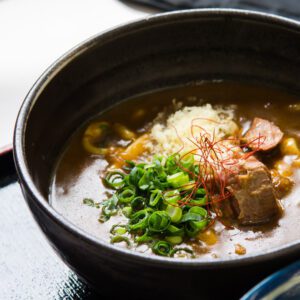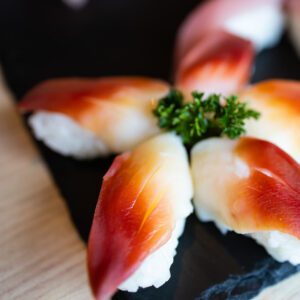Aomori’s local cuisine recommended in December
Table of contents
1.Introduction
The recommended local dishes of Aomori prefecture in December are “Ichigo-ni” and “Senbei-jiru”. “Ichigo-ni” and “Senbei-jiru” are selected as the “100 selections of local dishes” by the Ministry of Agriculture, Forestry and Fisheries. “Senbei-jiru”, a hot pot dish, becomes more delicious in the cold season.
https://www.maff.go.jp/j/nousin/kouryu/kyodo_ryouri/attach/pdf/190131-1.pdf
2.Ichigo-ni
“Ichigo-ni (Strawberry soup)” does not contain strawberries. “Ichigo-ni” is a sea urchin and abalone soup, and is called “Ichigo-ni” because the redness of the sea urchin looks like the fruit of a wild strawberry reflected in the morning haze. It’s a poetic name, but it’s a confusing name for those who hear it for the first time. The photo is of sea urchin and abalone, not “Ichigo-ni”.

In Aomori prefecture, the season for sea urchins that enter “Ichigo-ni” is from spring to early summer, and the season for abalone is from November to December, so if we give priority to abalone, “Ichigo-ni” is the most delicious time in December. However, Hashikami Town, which produces sea urchins and abalone in Aomori Prefecture, holds the “Ichigo-ni Festival” every year in late July. From this point of view, sea urchin is probably prioritized in the season of “Ichigo-ni”.
3.Senbei-jiru
“Senbei-jiru” is a soup made by adding Nambu sembei, which is exclusively for soup, and simmering it. Usually, senbei (rice crackers) are sweets, but it is unique to eat rice crackers as a meal. When I first ate it, I was surprised at how delicious it was. The taste and texture of the rice crackers soaked in the dashi soup stock from the ingredients is the best.
Both “Ichigo-ni” and “Senbei-jiru” are local dishes around Hachinohe City in the southern part of Aomori Prefecture. Hachinohe was under the control of Mr. Nanbu, who was based in Morioka, for a long time from the 1300s of the Kamakura period to the end of the Edo period. Therefore, Hachinohe has a deep connection with Iwate Prefecture as a cultural area, and both “Ichigo-ni” and “Senbei-jiru” are local dishes in the northern part of Iwate prefecture.
The place name of Hachinohe is one of Ichinohe, Ninohe, Sannohe, Gonohe, Rokunohe, Shichinohe, Hachinohe, and Kunohe. Of these, Ichinohe, Ninohe, and Kunohe are located in the northern part of Iwate Prefecture, and Sannohe, Gonohe, Rokunohe, Shichinohe, and Hachinohe are located in the southern part of Aomori Prefecture. The strength of the connection between the northern part of Iwate prefecture and the southern part of Aomori prefecture can be seen from the remaining place names.
4.Other local foods in Aomori
Unfortunately, the Ministry of Agriculture, Forestry and Fisheries’ “Local dishes loved by the nation” has not been selected from Aomori Prefecture. In general, the most famous local gourmet foods in Aomori Prefecture are “Miso Curry Milk Ramen” in Aomori City, “Bara-yaki” in Towada City, and “Hokki Don” in Misawa City. The photo is of curry ramen, not “miso curry milk ramen”.

The Sakhalin surf clam is also selected as the “PRIDE FISH” in winter in Aomori by Japan Fisheries Cooperatives. You can eat “Hokki Don” in Misawa City from December 1st to March 31st. The photo is of Sakhalin surf clam sushi, not “Hokki-don”.

